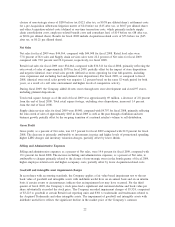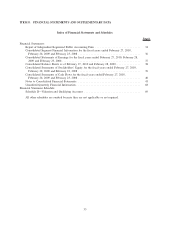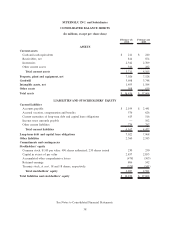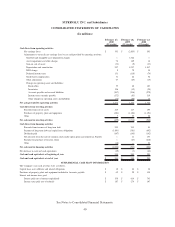Albertsons 2010 Annual Report Download - page 36
Download and view the complete annual report
Please find page 36 of the 2010 Albertsons annual report below. You can navigate through the pages in the report by either clicking on the pages listed below, or by using the keyword search tool below to find specific information within the annual report.Capital spending for fiscal 2010 was $691, including $10 of capital leases. Capital spending primarily included
store remodeling activity, new retail stores and technology expenditures. The Company’s capital spending for
fiscal 2011 is projected to be approximately $700, including capital leases.
Fiscal 2011 total debt reduction is estimated to be approximately $600.
OFF-BALANCE SHEET ARRANGEMENTS
Guarantees
The Company has guaranteed certain leases, fixture financing loans and other debt obligations of various
retailers as of February 27, 2010. These guarantees were generally made to support the business growth of
independent retail customers. The guarantees are generally for the entire terms of the leases or other debt
obligations with remaining terms that range from less than one year to 20 years, with a weighted average
remaining term of approximately nine years. For each guarantee issued, if the independent retail customer
defaults on a payment, the Company would be required to make payments under its guarantee. Generally, the
guarantees are secured by indemnification agreements or personal guarantees of the independent retail
customer. The Company reviews performance risk related to its guarantees of independent retail customers
based on internal measures of credit performance. As of February 27, 2010, the maximum amount of
undiscounted payments the Company would be required to make in the event of default of all guarantees was
approximately $127 and represented approximately $93 on a discounted basis. Based on the indemnification
agreements, personal guarantees and results of the reviews of performance risk, the Company believes the
likelihood that it will be required to assume a material amount of these obligations is remote. Accordingly, no
amount has been recorded in the Consolidated Balance Sheets for these contingent obligations under the
Company’s guarantee arrangements.
The Company is contingently liable for leases that have been assigned to various third parties in connection
with facility closings and dispositions. The Company could be required to satisfy the obligations under the
leases if any of the assignees are unable to fulfill their lease obligations. Due to the wide distribution of the
Company’s assignments among third parties, and various other remedies available, the Company believes the
likelihood that it will be required to assume a material amount of these obligations is remote.
The Company is a party to a variety of contractual agreements under which the Company may be obligated to
indemnify the other party for certain matters, which indemnities may be secured by operation of law or
otherwise, in the ordinary course of business. These contracts primarily relate to the Company’s commercial
contracts, operating leases and other real estate contracts, financial agreements, agreements to provide services
to the Company and agreements to indemnify officers, directors and employees in the performance of their
work. While the Company’s aggregate indemnification obligation could result in a material liability, the
Company is not aware of any matters that are expected to result in a material liability.
Multi-Employer Plans
The Company contributes to various multi-employer pension plans under collective bargaining agreements,
primarily defined benefit pension plans. These plans generally provide retirement benefits to participants based
on their service to contributing employers. Based on available information, the Company believes that some of
the multi-employer plans to which it contributes are underfunded. Company contributions to these plans could
increase in the near term. However, the amount of any increase or decrease in contributions will depend on a
variety of factors, including the results of the Company’s collective bargaining efforts, investment returns on
the assets held in the plans, actions taken by the trustees who manage the plans and requirements under the
Pension Protection Act and Section 412(e) of the Internal Revenue Code. Furthermore, if the Company was to
significantly reduce contributions, exit certain markets or otherwise cease making contributions to these plans,
it could trigger a partial or complete withdrawal that would require the Company to fund its proportionate
share of a plan’s unfunded vested benefits. The Company contributed $143, $147 and $142 to these plans for
fiscal 2010, 2009 and 2008, respectively.
30
























